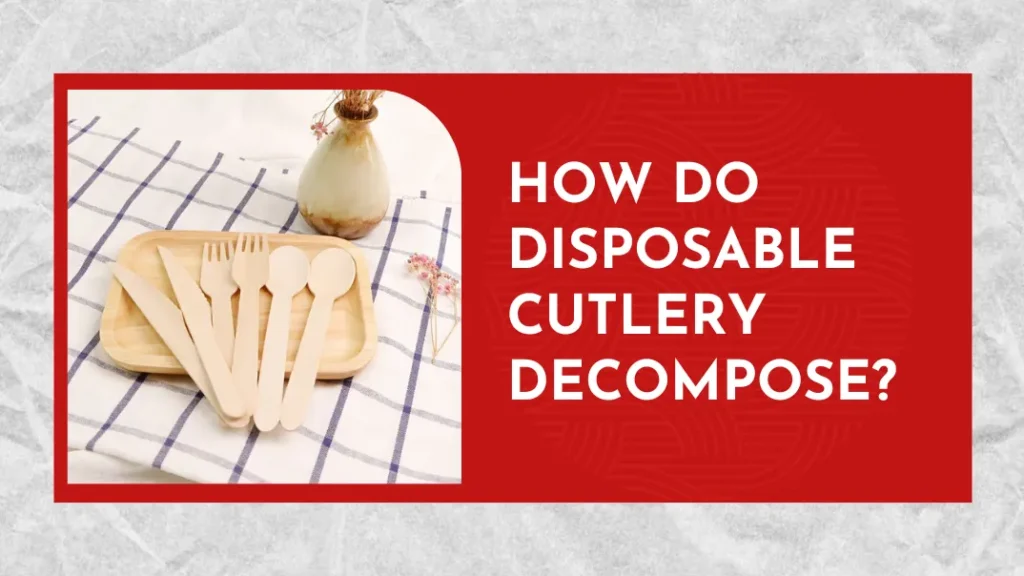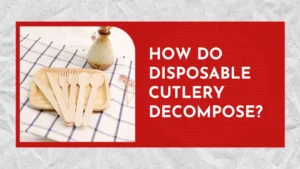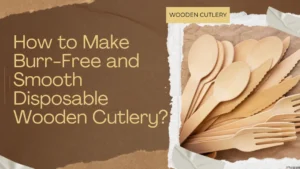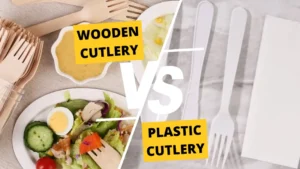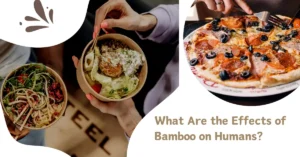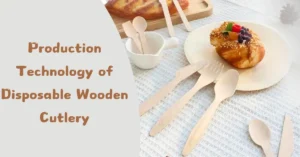Are you concerned about how long disposable cutlery lasts in the environment? Have you ever wondered how disposable cutlery decomposes? What happens to disposable cutlery when it’s discarded? What environmental damage could it cause? These are important questions to ask as disposable products become a major source of pollution worldwide.
When we dispose of disposable cutlery, the materials either break down or remain intact in the environment. The speed and manner of decomposition depend on the type of material. Some, like plastic, take decades to decompose, while others, such as biodegradable options, break down much faster.
This article details how various disposable cutlery types decompose, their environmental impact, and what you can do to make more sustainable choices. Knowing how disposable cutlery decomposes empowers you to make better decisions regarding its use, disposal, and alternatives. Whether you’re a consumer or a business owner, you have the power to reduce waste and make a positive environmental impact.
Understanding Disposable Cutlery
Disposable cutlery has become a widespread solution for many of our fast-paced, single-use meal occasions. From picnics to food delivery services, disposable cutlery seems the easiest option. However, the environmental consequences of constantly using these products are far from negligible.
Most disposable cutlery falls into one of three categories: plastic, wooden, or biodegradable materials. Each type has a different environmental impact on disposal and decomposition. Understanding the materials and their breakdown is essential for making conscious, eco-friendly decisions.
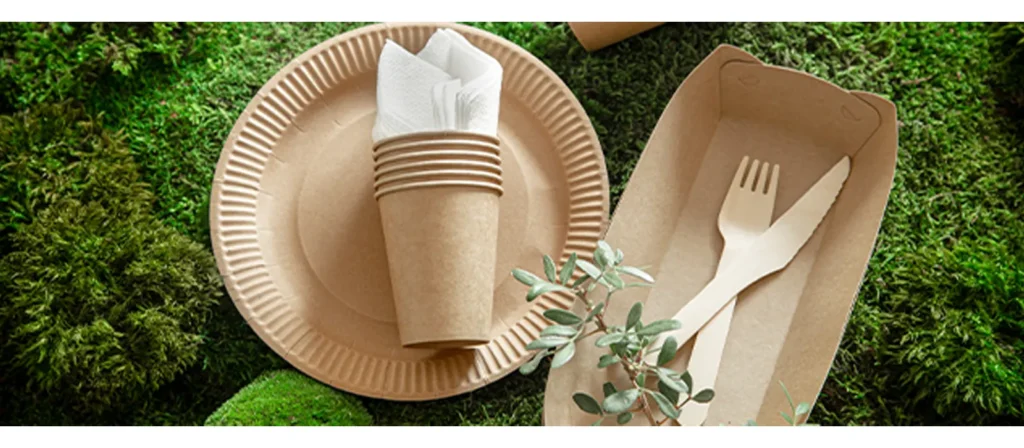
How Long Does It Take for Disposable Cutlery to Decompose?
The time it takes for disposable cutlery to decompose depends on the material it is made from and the conditions it is exposed to. The process is painfully slow for plastic, taking hundreds or even thousands of years. On the other hand, bamboo cutlery can decompose within months, but only if the right environmental conditions are met.
Typical Decomposition Time
The decomposition time for disposable cutlery depends largely on the material it is made from. The time ranges from just a few months to several centuries. Let’s look at the different types:
- Plastic Cutlery: 500 to 1,000 years
- Wooden Cutlery: 6 months to 1 year (under ideal conditions)
- Bamboo Cutlery: 6 months to 2 years
- Compostable Cutlery (cornstarch, etc.): 3 to 6 months (if composted in proper conditions)
These times represent ideal circumstances. Many factors, such as temperature, moisture, and exposure to microbes, can influence how quickly or slowly the cutlery decomposes.
Comparison of Decomposition Time of Disposable Wooden Cutlery Materials
| Material Type | Decomposition Time | Breakdown Process |
|---|---|---|
| Bamboo | 6 months to 1 year | Biodegradable, compostable |
| Wooden (Birch, Pine) | 6 months to 1 year | Biodegradable, slow decomposition |
| Cornstarch | 3 to 6 months | Fully compostable in proper environments |
Decomposition Timeline of Different Types of Disposable Cutlery
| Cutlery Type | Decomposition Time | Ideal Decomposition Environment | Additional Notes |
|---|---|---|---|
| Plastic | 500 to 1,000 years | Landfill or ocean exposure | Microplastics remain harmful |
| Biodegradable | 6 months to 1 year | Industrial composting or landfill | Requires proper conditions |
| Bamboo | 6 months to 2 years | Composting or landfill | Eco-friendly option but still takes time |
| Wooden | 6 months to 1 year | Composting or landfill | Similar to bamboo, but may vary |
| Compostable | 3 to 6 months | Industrial composting | Breaks down fully in proper composting facilities |
Decomposition Time of Disposable Wooden Cutlery vs Plastic Cutlery
| Cutlery Type | Decomposition Time | Impact on Environment |
|---|---|---|
| Plastic Cutlery | 500 to 1,000 years | Major pollutant, long-lasting environmental impact |
| Wooden Cutlery | 6 months to 1 year | More sustainable, but still adds waste |
Factors Affecting the Decomposition Time of Wooden Cutlery
The decomposition time of wooden cutlery varies depending on several factors. Understanding these factors can help us predict how quickly or slowly these materials will break down.
1. Composting Environment
Composting significantly speeds up the decomposition process. Wooden cutlery disposed of in a well-maintained compost pile or industrial composting facility can break down quickly. However, decompression is much slower in landfills, where conditions aren’t optimal.
2. Materials and Treatment
The type of wood used and whether it has been treated with chemicals (e.g., preservatives or varnishes) will impact the decomposition time. Wood treated with chemicals may take longer to decompose and could release harmful chemicals into the soil as it breaks down.
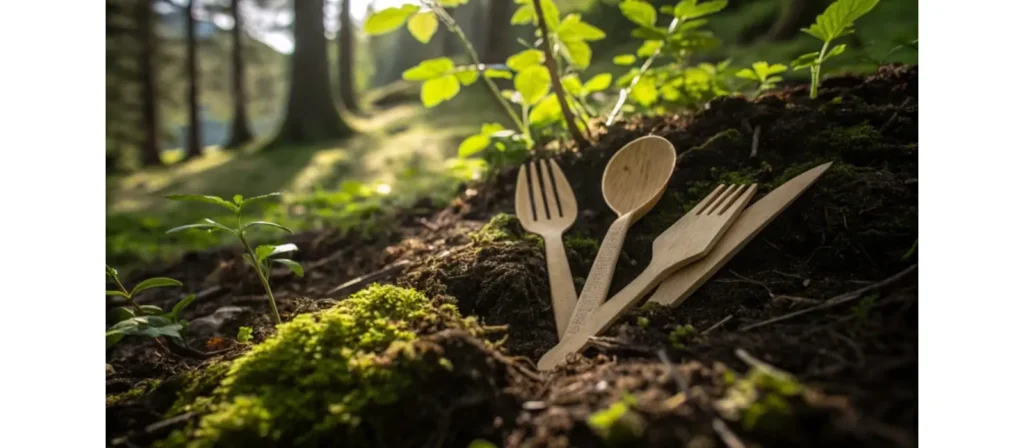
3. Thickness and Size
Thicker pieces of cutlery take longer to decompose because they have more material for microorganisms to break down. Larger, thicker spoons or forks will take longer than thinner, smaller pieces.
4. Temperature and Climate
Warm temperatures and high humidity levels promote faster microbial activity, speeding up decomposition. In cold or dry climates, decomposition can take significantly longer.
5. Environmental Conditions
Air circulation, moisture, and sunlight can all impact how quickly cutlery decomposes. Composting environments with proper moisture and oxygen flow tend to break down materials faster than those lacking these conditions.
| Environmental Factor | Effect on Decomposition Time |
|---|---|
| Temperature | Higher temperatures accelerate the breakdown process. Colder temperatures slow it down. Ideal composting conditions are around 60-70°F (15-21°C). |
| Moisture Level | Adequate moisture is needed for microbial activity. Dry conditions can slow the process. Excess moisture can lead to anaerobic conditions, which also slow decomposition. |
| Oxygen Availability | Oxygen-rich environments, such as those in composting piles, allow microbes to thrive and decompose the wood faster. Lack of oxygen in landfills slows the process. |
| Soil Composition | Rich, nutrient-dense soils support microbial activity, speeding up decomposition. Poor soil conditions can inhibit microorganism growth, leading to slower breakdown. |
6. Chemical Treatment and Coating
Some wooden cutlery is coated with chemical finishes, which can slow down or even prevent decomposition. These coatings may not be biodegradable, which can extend the life of the cutlery in landfills.
7. Processing Technology
The method used to process the cutlery can also affect its decomposition. For example, if wooden cutlery is chemically treated or processed with preservatives, it may not break down as quickly as untreated wood.
8. Influence of Soil Microorganisms
Soil microorganisms, including bacteria and fungi, break down organic materials. The more active and diverse the microbial community in the soil, the faster the decomposition process will occur.
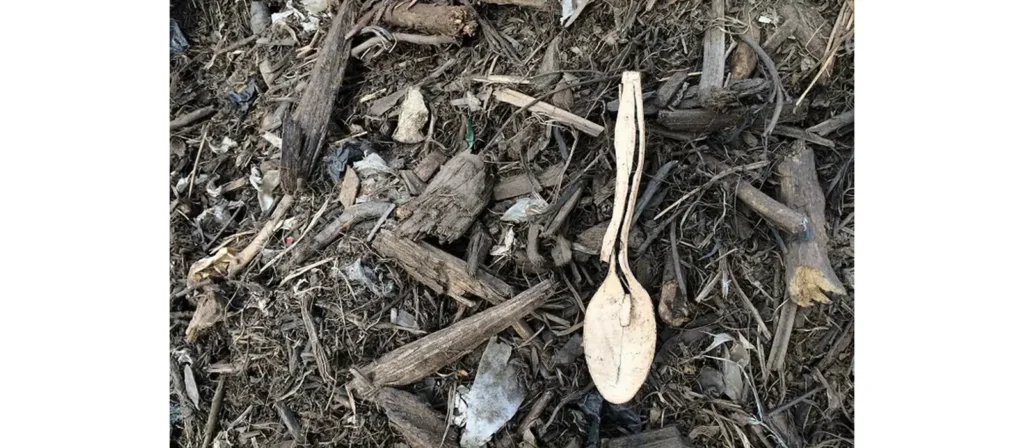
Process of Disposable Cutlery Decompose
Understanding the decomposition process of disposable cutlery helps us evaluate its environmental impact. Generally, the decomposition of cutlery can be broken into several stages:
- Plastic Cutlery
Plastic cutlery doesn’t degrade biologically. Instead, it slowly breaks into microplastics over time. These microplastics continue polluting the environment, affecting ecosystems, wildlife, and human health. - Wooden Cutlery
Wooden cutlery undergoes natural biodegradation. Bacteria and fungi break down the wood’s cellulose, returning it to the soil as organic matter. This process is much more sustainable than plastic, but it still takes time, especially if not composted properly. - Bamboo Cutlery
Bamboo is a natural fiber that breaks down similarly to wood. Its key advantage is its rapid growth, making it a renewable resource. However, it still needs the right conditions to decompose efficiently. - Compostable Cutlery
Compostable cutlery is made from cornstarch, sugarcane, or other plant-based ingredients. These materials break down relatively quickly in a well-managed composting environment, leaving behind no harmful residue.
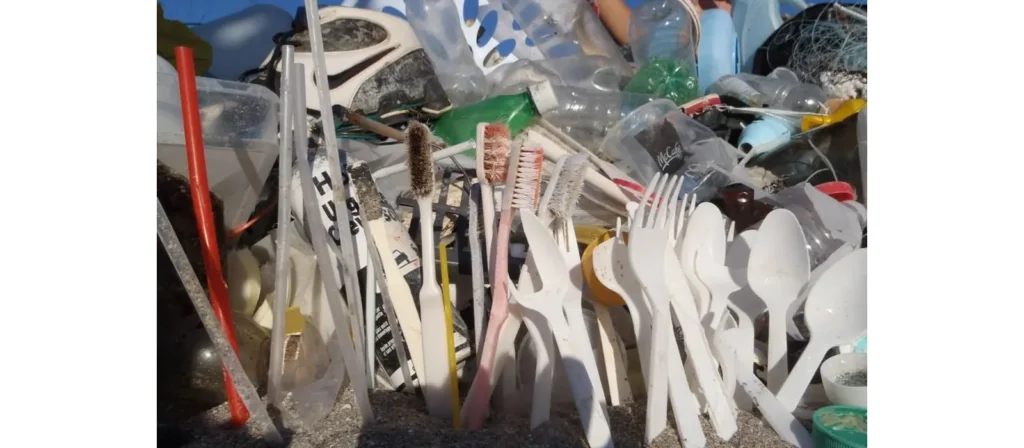
What Impact Does Disposable Cutlery Have on the Environment?
The impact of disposable cutlery on the environment is severe, as millions of pieces are discarded daily. Most disposable cutlery is made from plastic, contributing significantly to pollution. Since plastic cutlery takes hundreds of years to decompose, it accumulates in landfills and oceans, posing threats to wildlife. While some alternatives, like wooden cutlery, are biodegradable, they still need specific conditions to break down efficiently.
The issue becomes even more critical when we consider the plastic pollution crisis. Plastic pollutes the oceans and releases toxic substances into the soil, harming plant life and ecosystems. Therefore, it’s imperative to seek environmentally friendly and biodegradable alternatives.
Tips for the Correct Handling of Wooden Cutlery
Wooden cutlery is a more sustainable alternative but requires proper handling to maximize lifespan and decomposition. Here are a few tips to make sure you’re handling it responsibly:
- Use it in suitable environments: Wooden cutlery works best in natural, compostable settings where it can decompose properly. Avoid storing it in humid or damp areas, as moisture can cause premature decay.
- Avoid chemical coatings: Wooden utensils often come with coatings to increase durability. However, these chemicals can make it harder for the wood to decompose, so choose uncoated wooden cutlery when possible.
- Compost it properly: If you can, compost your wooden cutlery. A good composting facility speeds up the breakdown process and returns the nutrients to the earth.
- Store it correctly: Keep wooden cutlery in dry conditions before use. This will help prevent it from becoming brittle or degraded before using it.
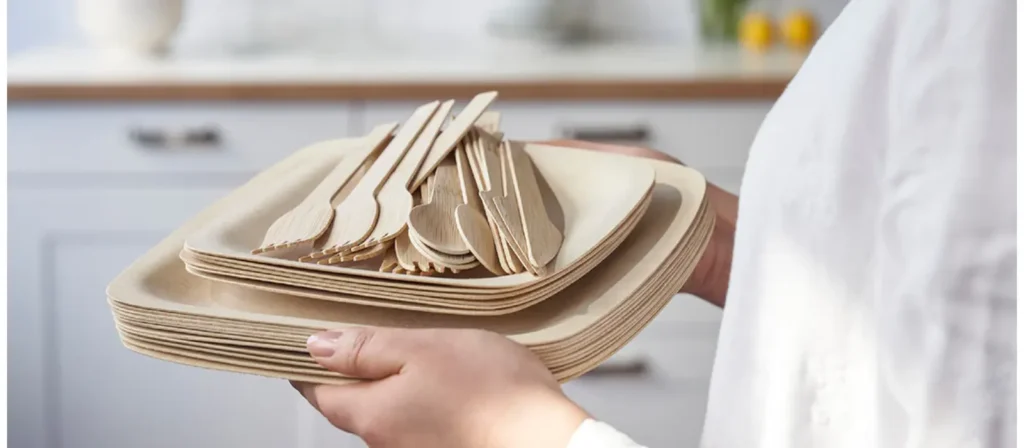
Compostable Cutlery vs. Biodegradable Cutlery
While “compostable” and “biodegradable” are often used interchangeably, they differ. Understanding the difference between these two types of cutlery can help you make better environmental choices.
Compostable Cutlery
Compostable cutlery is made from cornstarch, bamboo, or sugarcane and is designed to break down in composting environments. Under the right conditions, it will decompose into natural elements like water, carbon dioxide, and biomass. It’s important to note that compostable cutlery needs to be processed in industrial composting facilities, as home composting may not generate enough heat or moisture for full decomposition.
Biodegradable Cutlery
Biodegradable cutlery, on the other hand, breaks down naturally over time through microbial activity. However, depending on the material and environmental conditions, biodegradable products can still take months or years to decompose. Many biodegradable cutlery items are made from plant-based materials such as PLA (polylactic acid) derived from corn starch. While biodegradable, these materials still require proper conditions, such as high humidity or heat, to break down effectively.
Key Differences:
| Property | Compostable Cutlery | Biodegradable Cutlery |
|---|---|---|
| Decomposition Time | Quick in composting conditions (2–4 months) | Slow (depends on the material) |
| Decomposition Process | Breaks down into natural components in composting environments | Breaks down but may leave some residues |
| Disposal Method | Must be composted in proper facilities | Can decompose in natural environments but slower |
| Environmental Benefit | High – minimal environmental impact when composted correctly | Medium – still requires time to break down |
How Does Wooden Cutlery Decompose in a Landfill?
While wooden cutlery is biodegradable, it doesn’t always break down as quickly as in a composting environment. When disposed of in a landfill, the decomposition process slows significantly due to the lack of oxygen and moisture.
In a landfill, wood breaks down anaerobically (without oxygen), prolonging decomposition. While it eventually breaks into organic matter, the timeframe can extend to several years—much longer than in a composting facility.
Moreover, if the wooden cutlery is treated with chemicals or coatings, this process can take longer, as the treatments impede microbial activity. In the worst-case scenario, wooden cutlery in landfills contributes to waste accumulation and pollution, although it is still more environmentally friendly than plastic.
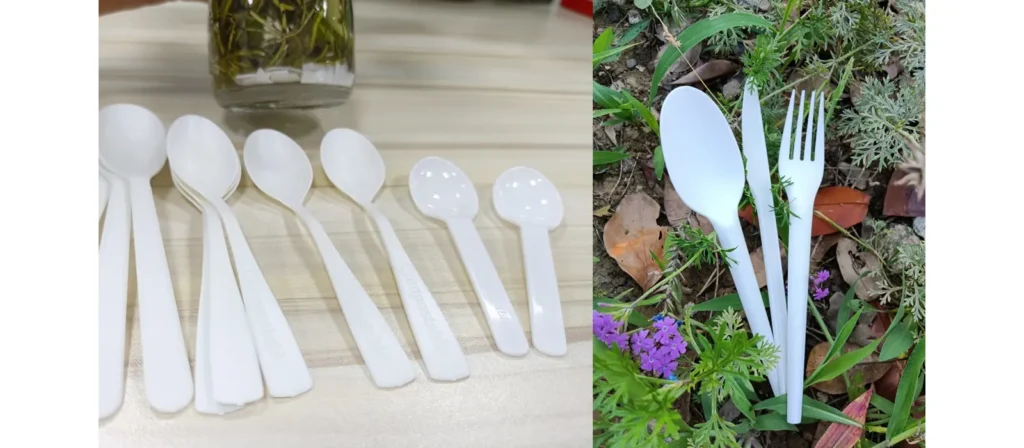
FAQ
- How long does plastic cutlery take to decompose?
Depending on environmental conditions, plastic cutlery can take 500 to 1,000 years to decompose. - Is biodegradable cutlery better for the environment?
Yes, biodegradable cutlery decomposes faster than plastic, but it still requires proper composting conditions to break down effectively. - Can biodegradable cutlery be composted at home?
Yes, biodegradable cutlery can be composted at home if made from the right materials, like bamboo or cornstarch. - What’s the environmental impact of disposable plastic cutlery?
Plastic cutlery contributes to landfill waste, marine pollution, and soil contamination, taking centuries to break down. - Are there alternatives to disposable cutlery?
Yes, alternatives include reusable cutlery, compostable cutlery, wooden or bamboo cutlery, and even edible cutlery. - How can I dispose of disposable cutlery properly?
If available, dispose of plastic cutlery in recycling bins. Biodegradable options can be composted in industrial composting facilities for optimal breakdown. - What affects how quickly wooden cutlery decomposes?
Factors like temperature, moisture, microbial activity, and whether the wood is treated with chemicals can affect decomposition speed.
Conclusion
The decomposition process of disposable cutlery varies greatly depending on the material it’s made from. While plastic cutlery can take hundreds of years to break down, biodegradable alternatives offer a quicker solution. However, even biodegradable cutlery has its limitations, especially if not disposed of properly.
To reduce the environmental impact of disposable cutlery, we must make conscious choices by opting for sustainable alternatives like reusable or compostable options. By doing so, we can help protect the planet and reduce the long-lasting effects of plastic pollution.

